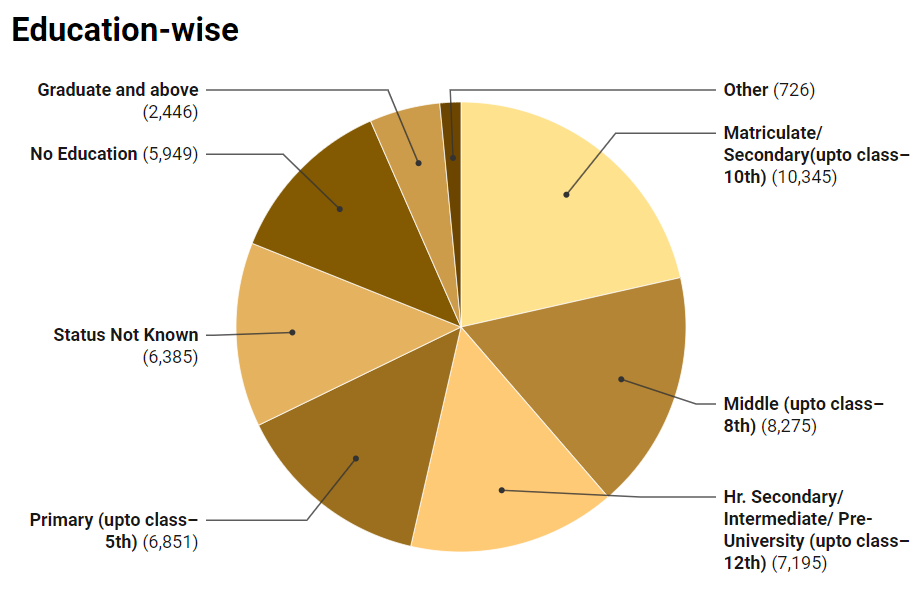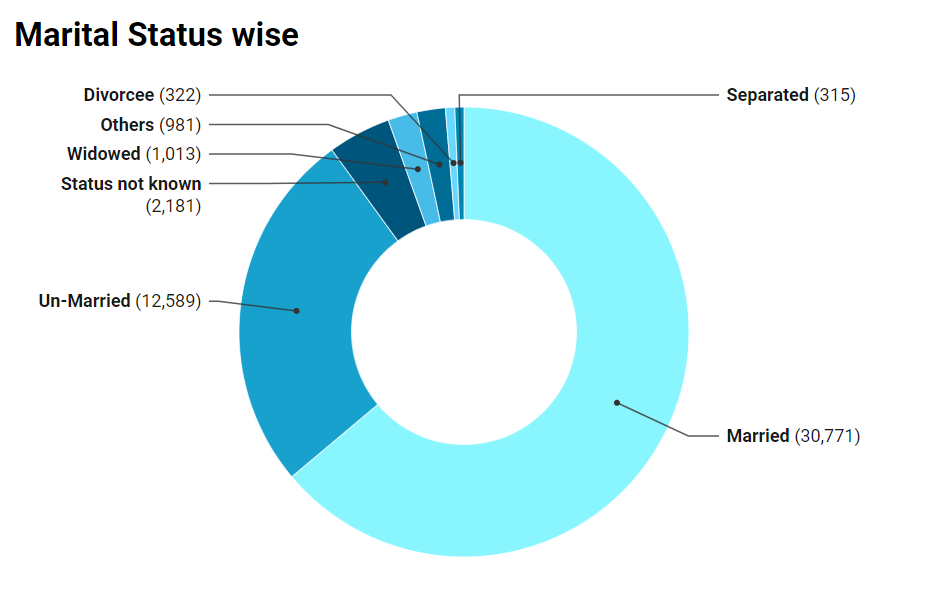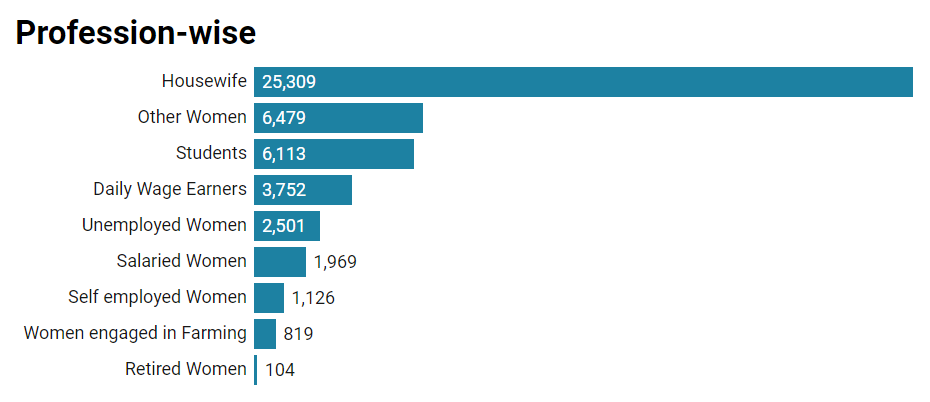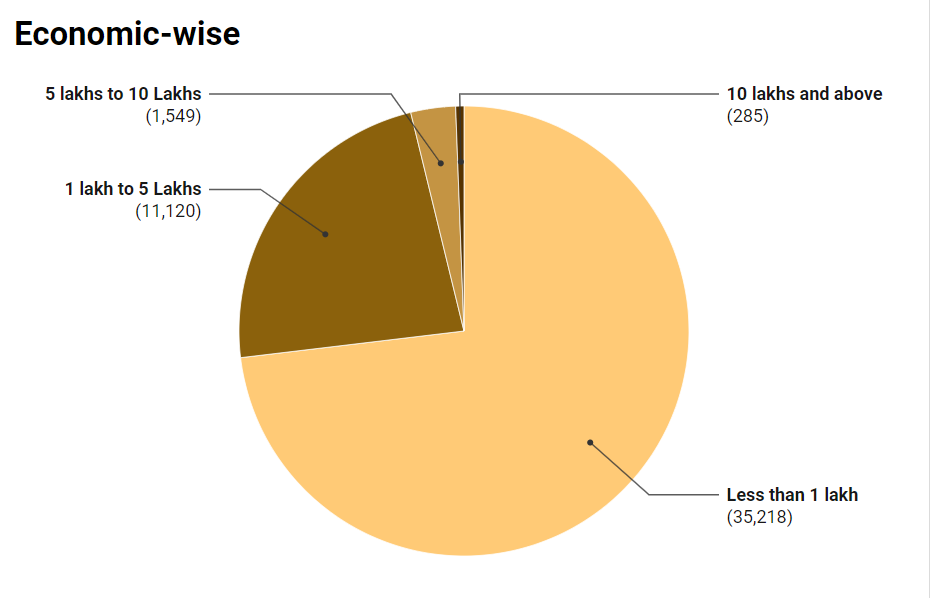Introduction
Following our earlier exploration of geographic and age-related patterns in women suicides, as well as the causes and means adopted, we now turn our attention to more personal factors that influence the risk of women suicides. Education, marital status, professional engagement, and income play critical roles in shaping an individual’s mental health and life circumstances. In this second part of our blog series, we will examine how these elements impact women suicides in India.
By focusing on these personal dimensions, this blog builds on the previous one, providing a more nuanced understanding of the challenges faced by women across different stages of life. Together, these insights highlight the need for targeted interventions that address both the societal and individual-level factors contributing to women suicides. The data used here is released by Ministry of Home Affairs, India.
Table of Contents
1. Impact of Educational Attainment on Suicide Incidence

1. Highest Incidence Among Matriculate/Secondary (Class 10) Level:
10,345 cases come from individuals with education up to Class 10 (Matriculate/Secondary), making this group the largest.
Possible contributing factors for this group include:
- Pressure of board exams: Students facing board exams at the 10th-grade level may experience intense academic pressure, which can contribute to mental distress.
- Limited job opportunities: For individuals who do not pursue further education, employment opportunities may be limited, leading to financial stress and feelings of inadequacy.
- Social and family expectations: After completing 10th grade, individuals often face high expectations from family and society to perform well, leading to increased stress and potential feelings of failure.
2. Significant Numbers Among Middle School and Higher Secondary Levels:
8,275 cases involve individuals educated up to Class 8 (Middle School), while 7,195 cases come from those educated up to Class 12 (Higher Secondary).
Key contributing factors include:
- Lack of educational and career progression: Many individuals in this group may struggle with transitioning from school to further education or work. Those not able to continue to higher education may feel limited in their career prospects.
- Examination stress and peer pressure: Those still in school or recently graduated may experience intense pressure to succeed academically, particularly during the 12th-grade board exams, which are critical for future career paths.
- Employment challenges: Those with only secondary or middle school education may face challenges in securing stable or well-paying jobs, contributing to economic stress and mental health issues.
3. High Count of Primary Education and No Education:
6,851 cases are from individuals with Primary Education (Class 5 and below), and 5,949 cases involve those with No Education.
Contributing factors for this group may include:
- Economic hardship: Lack of education is often closely tied to economic challenges, as individuals with lower educational attainment typically have fewer job opportunities and lower income potential.
- Social exclusion and limited resources: Individuals with little or no education may face social exclusion or stigma, reducing their access to social support, mental health resources, or opportunities for self-improvement.
- Lack of coping mechanisms: Those without education may lack awareness of mental health resources and coping strategies, making them more vulnerable to depression or suicidal thoughts in times of hardship.
4. Status Not Known:
- 6,385 cases have an unknown education status. This suggests incomplete data collection, which makes it difficult to draw specific conclusions. However, it could imply that individuals from this group were in unreported or informal education systems.
5. Graduate and Above, Diploma Holders, and Professionals:
2,446 cases are from Graduates and Above, while 551 cases involve individuals with Diplomas or Certificates. There are 175 cases among professionals (MBA, etc.).
While this is a smaller group compared to others, several factors contribute to women suicides risk among educated individuals:
- High expectations and career pressure: Graduates and professionals often face high expectations in their careers, and any failure to meet these expectations can lead to significant emotional distress.
- Unemployment or underemployment: Even among educated individuals, a lack of job opportunities or being stuck in underemployment can cause frustration and hopelessness.
- Debt or financial strain: Many diploma holders and graduates may face student loan debt or financial burdens if their career does not progress as expected.
6. Impact of Educational Level on Mental Health:
- Lower education levels often correlate with economic struggles, job insecurity, and social exclusion, all of which can contribute to poor mental health and a higher risk of women suicides.
- Higher education levels, though representing a smaller number of cases, can also be linked to stress factors such as professional competition, high expectations, and economic pressures.
Key Insights:
- The highest number of suicide cases are among individuals with education levels up to Class 10 (Matriculate/Secondary), highlighting significant stress factors associated with academic performance and limited career opportunities.
- Individuals with middle and primary education levels also represent a substantial portion, suggesting economic and social hardships contribute significantly to mental health challenges.
- Uneducated individuals face unique challenges such as social exclusion, lack of opportunities, and difficulty accessing mental health resources, all of which elevate the risk of women suicides.
- Even graduates and professionals, while fewer in number, experience stress related to job competition, career stagnation, and financial pressure, showing that suicide risk is not confined to less-educated groups.
Potential Interventions:
- Educational and career counseling: For students at matriculate and higher secondary levels to reduce exam stress and provide guidance on future opportunities.
- Job skill training and support: For individuals with limited education to improve employment opportunities and reduce financial stress.
- Awareness and mental health education: Especially targeting less-educated groups, to provide resources for coping with stress, identifying mental health challenges, and seeking help.
- Career progression programs for graduates: To help them navigate the challenges of job markets and expectations post-education, reducing the stress associated with professional life.
2. Impact of Marital Status on Suicide Rates: Analyzing Relationship Dynamics and Mental Health

1. Majority of Cases Among Married Individuals:
30,771 cases are from married individuals, making it the largest group by a significant margin. This highlights that marriage, while generally associated with emotional and social stability, can also be a source of stress, leading to women suicides in certain circumstances. Possible contributing factors include:
- Family pressure and responsibilities: Married individuals often face significant social and familial responsibilities, which can create emotional and financial stress.
- Relationship issues: Marital problems such as domestic violence, lack of communication, and infidelity may lead to mental health challenges.
- Isolation within marriage: Some individuals might feel isolated or trapped in unsatisfactory marriages, leading to feelings of hopelessness.
2. High Count Among Unmarried Individuals:
12,589 cases come from unmarried individuals, representing the second-largest group. Contributing factors may include:
- Social stigma or pressure to marry: In many societies, unmarried individuals may face pressure or stigma, leading to mental distress.
- Loneliness or lack of emotional support: Without a partner, some individuals may lack emotional support, which could exacerbate feelings of isolation or depression.
- Financial instability: Unmarried individuals might face more financial challenges due to the lack of dual income or support from a spouse.
3. Unknown Marital Status:
- 2,181 cases are listed as having an unknown marital status. While it’s difficult to draw specific conclusions from this group, it may include individuals whose personal or social circumstances were unclear at the time of reporting.
4. Suicide Among Widowed Individuals:
1,013 cases come from widowed individuals. The key contributing factors likely include:
- Grief and loss: The death of a spouse can trigger intense grief, loneliness, and a sense of purposelessness, especially in older individuals.
- Social isolation: Widowed individuals may feel isolated without their spouse, particularly if their social circle was centered around their married life.
- Financial stress: The loss of a partner may lead to financial difficulties, adding another layer of stress.
5. “Other” Marital Status:
- 981 cases are categorized as “Others,” which may include non-traditional relationships, partners living together, or individuals in undefined relationship statuses. The risk factors in this category likely mirror those seen in married or unmarried individuals.
6. Divorcee and Separated Individuals:
322 cases (Divorcees) and 315 cases (Separated individuals) show that divorce or separation is a significant factor in women suicides cases. Key contributing factors include:
- Emotional turmoil from relationship breakdown: Divorce or separation can trigger feelings of rejection, guilt, failure, and loneliness.
- Legal and financial strain: Divorce can also come with legal battles and financial strain, adding stress.
- Social stigma: In some societies, being divorced or separated may still carry social stigma, leading to isolation or feelings of inadequacy.
Key Insights:
- Married individuals make up the largest group of suicide cases (30,771), highlighting the need for mental health resources focused on married couples and family issues.
- Unmarried individuals (12,589) also represent a significant portion of cases, pointing to the challenges of loneliness, societal pressure, and lack of emotional support.
- Widowed individuals (1,013) face unique mental health challenges, likely due to grief, isolation, and financial difficulties following the loss of a spouse.
- Divorcees and separated individuals (637 total) show elevated risk, particularly due to the emotional and financial difficulties surrounding relationship breakdowns.
- Mental health resources should be tailored to support individuals at different stages of relationships, particularly those facing grief, separation, or societal pressure due to their marital status.
Potential Interventions:
- Support systems for married individuals facing family and relationship stress.
- Grief counseling for widowed individuals to address emotional and financial challenges.
- Social and emotional support for unmarried individuals dealing with loneliness or societal pressure.
- Counseling and legal aid for individuals going through divorce or separation.
3. Occupational Vulnerability and Suicide

1. Dominant Group: Housewives
Housewives form the largest category, with 25,309 suicides, accounting for a vast majority of cases. This high number reflects the intense pressures faced by women in traditional domestic roles. Possible contributing factors include:
- Isolation and lack of social support: Many housewives may feel isolated due to limited social interaction.
- Family and societal expectations: The weight of fulfilling household responsibilities and managing family dynamics can lead to immense stress.
- Financial dependence: A lack of financial autonomy may result in feelings of powerlessness and helplessness.
- Mental health stigma: Mental health challenges might go unaddressed due to societal norms and lack of awareness.
2. Students
Students represent the second-largest group, with 6,113 cases. The pressures faced by students include:
- Academic stress: Intense competition and expectations to excel in examinations can lead to feelings of inadequacy.
- Future uncertainty: Many students might struggle with anxiety about their future prospects, career paths, or job security.
- Peer pressure: Social comparisons and the need to fit in can exacerbate feelings of inadequacy or isolation.
- Mental health awareness: Despite growing awareness, mental health support might still be lacking, leading to undiagnosed and untreated mental health conditions.
3. Daily Wage Earners
Daily wage earners rank third, with 3,752 suicides. This group is particularly vulnerable due to:
- Economic instability: The uncertainty of daily income and the inability to meet basic needs can lead to severe financial stress.
- Exploitation and poor working conditions: Many daily wage earners may face exploitation, unsafe work environments, and limited job security.
- Limited access to healthcare: Mental and physical health issues may go untreated due to lack of resources.
4. Unemployed Persons
Unemployment is a major factor, with 2,501 cases. The psychological impacts of being jobless include:
- Financial distress: The inability to provide for oneself or one’s family can lead to feelings of worthlessness.
- Social stigma: Unemployment can result in societal shame and personal embarrassment.
- Isolation and depression: Lack of purpose and routine often leads to mental health struggles, further increasing the risk of women suicides.
5. Other Persons
- The “Other” category represents a significant number of cases. This includes individuals who do not fall under the specific professions listed. These could be people with informal, undefined roles in society or those who do not identify with a specific career path.
6. Salaried Persons
Salaried persons account for 1,969 suicides, which, while lower in number compared to housewives and students, still represents a concerning issue. Contributing factors include:
- Job stress: Many salaried individuals may face high work pressure, job insecurity, or toxic work environments.
- Work-life imbalance: The inability to balance work demands with personal life can lead to burnout and mental health struggles.
- Corporate expectations: Meeting professional goals and dealing with performance appraisals can cause anxiety.
7. Self-Employed Persons
Self-employed individuals also face significant challenges that contribute to women suicides, including:
- Financial risk and uncertainty: Running a business or working independently often involves financial risks, and business failure can lead to distress.
- Lack of security: Self-employed individuals may not have access to benefits like healthcare, insurance, or retirement plans, increasing their vulnerability.
8. Farming and Agriculture
Persons engaged in farming make up 819 cases. The factors contributing to suicides in this group are well-documented, particularly:
- Debt and financial instability: Many farmers struggle with debt due to crop failure, market instability, and reliance on loans.
- Environmental challenges: Droughts, floods, or other natural disasters can devastate crops and livelihoods.
- Isolation and lack of mental health support: Farmers often work in remote locations, with limited access to support systems or mental health services.
9. Retired Persons
Retired persons are the smallest category, with 104 cases. Contributing factors include:
- Loss of purpose or identity: Retirement can lead to feelings of purposelessness or depression due to the sudden loss of a structured routine.
- Financial insecurity: Some retirees may face financial struggles, especially if their pensions or savings are insufficient.
- Health issues: Aging-related health problems can exacerbate mental health challenges.
Key Insights:
- Housewives and Students are the most vulnerable groups in terms of suicides, reflecting the immense societal pressures they face.
- Economic factors such as unemployment, daily wage work, and financial instability are significant contributors across various professional categories.
- Mental health support across all professional sectors is critical, particularly for those facing economic hardship, job insecurity, and family pressures.
- Farming and self-employment suicides highlight the vulnerability of those in occupations with high financial risks and limited social safety nets.
4. Income Disparities and Suicide

1. Majority in Lower Income Bracket (Less than ₹1 Lakh):
35,218 cases (the vast majority) fall in the income bracket of less than ₹1 lakh. This indicates that low-income individuals are disproportionately affected by suicide, likely due to:
- Financial stress: Individuals in this category may face chronic financial instability, struggling to meet basic needs like housing, food, and healthcare.
- Lack of opportunities: Low-income earners may experience limited upward mobility, contributing to feelings of hopelessness or frustration.
- Debt and unemployment: Many individuals in this group may also be facing job instability, high debts, or inadequate social support systems.
2. Moderate Earnings (₹1 lakh to ₹5 lakhs):
11,120 cases fall into the earnings bracket of ₹1 lakh to ₹5 lakhs, the second largest group. Though individuals in this income range are likely more financially stable than those earning less than ₹1 lakh, they may still face:
- Financial pressure to maintain lifestyle: Those in this group may feel pressure to maintain a certain standard of living, often with limited savings or security.
- Societal expectations: Individuals may face societal pressure to appear successful, which can exacerbate stress if they are struggling financially or professionally.
3. Higher Earnings (₹5 lakhs to ₹10 lakhs):
1,549 cases come from the ₹5 lakhs to ₹10 lakhs income group. While fewer cases are found in this category, it still represents a significant number, indicating that women suicides affects individuals across income levels. Contributing factors may include:
- Work-related stress: Individuals in this income bracket may hold jobs with significant responsibilities and high expectations.
- Pressure to succeed: They may face pressure to continue advancing in their careers or maintain a high standard of living, leading to burnout.
- Lifestyle and social comparisons: Keeping up with social expectations and maintaining financial stability in this group can still be stressful.
4. Highest Earners (₹10 lakhs and above):
285 cases are found in the earnings bracket of ₹10 lakhs and above, the smallest group. Even though this income group has more financial resources, they are not immune to mental health challenges. Key factors may include:
- Job-related stress: High-income earners are likely to be in positions of authority or responsibility, where work pressure is intense and constant.
- Isolation and loneliness: Wealth does not protect against feelings of isolation, and some individuals in this category may face emotional loneliness or lack of social support.
- Performance pressure: High achievers often experience immense internal and external pressure to perform, leading to stress and anxiety.
Key Insights:
- Low-income earners (less than ₹1 lakh) account for the overwhelming majority of suicides, highlighting the vulnerability of financially unstable individuals to severe mental health challenges.
- Middle-income earners also face significant risks, likely due to job stress, societal pressures, and financial instability, though the numbers decrease as income levels rise.
- High-income individuals are not exempt from women suicides, though their numbers are much lower, suggesting that mental health issues can affect individuals regardless of financial stability.
- Socioeconomic factors such as financial insecurity, societal expectations, and lifestyle pressures are critical drivers of women suicides across all income levels.
Conclusion
The impact of education, marital status, profession, and income on women suicides rates in India is profound. These factors influence a woman’s sense of agency, mental health, and resilience in the face of societal pressures. As we’ve seen, higher levels of education or income do not always offer protection, and in some cases, they may add new forms of stress. Marital challenges, unemployment, and financial instability also compound the risk.
This blog, along with the first part of our series, underscores the multifaceted nature of women suicides in India. By addressing both societal patterns and personal circumstances, we can work toward more effective prevention strategies, offering hope to women facing such challenges and helping to reduce the tragic loss of life. If you haven’t yet, I encourage you to read the first part of this series, where we explore the broader geographic and age-related trends in women suicides. Together, these analyses form a comprehensive view of this critical issue.
